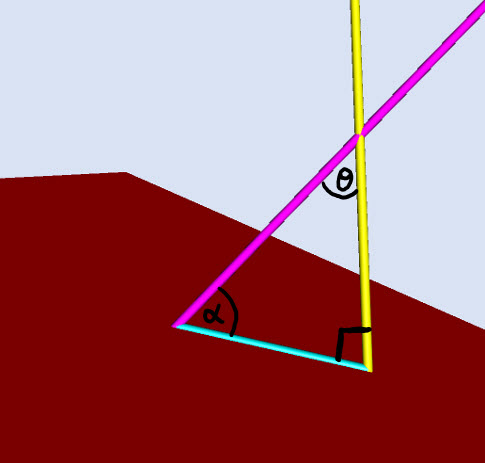 In this topic, we will look at finding the angle between vectors in different circumstances. The whole topic revolves around the scalar (or dot) product. Often we are concerned with perpendicular vectors, and the fact that the scalar product equals zero in this case is a hugely important result. Since problems are often set in 3 dimensions, the ability to visualise the situations or draw a quick sketch can help.
In this topic, we will look at finding the angle between vectors in different circumstances. The whole topic revolves around the scalar (or dot) product. Often we are concerned with perpendicular vectors, and the fact that the scalar product equals zero in this case is a hugely important result. Since problems are often set in 3 dimensions, the ability to visualise the situations or draw a quick sketch can help.
On this page, you should learn about
- the scalar product of two vectors
- the angle between two vectors
- parallel and perpendicular vectors
The following videos will help you understand all the concepts from this page
In the following video, we are going to look at the scalar product and how we can use it to find the angle between two vectors. The scalar product, or the dot product as it is sometimes called, is a way of combining two vectors together that will give us a result that is a scalar (not a vector). The formula for finding the scalar product for 3D can be found in the formula booklet (it is not there for 2D)
| 2 dimensions | \({ v }\cdot { w }=\left( \begin{matrix} { v }_{ 1 } \\ { v }_{ 2 } \end{matrix} \right) \cdot \left( \begin{matrix} { w }_{ 1 } \\ { w }_{ 2 } \end{matrix} \right) ={ v }_{ 1 }\cdot { w }_{ 1 }+{ v }_{ 2 }\cdot { w }_{ 2 }\) |
| 3 dimensions | \(\textbf{ v}\cdot \textbf{w }=\left( \begin{matrix} { v }_{ 1 } \\ { v }_{ 2 } \\ { v }_{ 3 } \end{matrix} \right) \cdot \left( \begin{matrix} { w }_{ 1 } \\ { w }_{ 2 } \\ { w }_{ 3 } \end{matrix} \right) ={ v }_{ 1 }\cdot { w }_{ 1 }+{ v }_{ 2 }\cdot { w }_{ 2 }+{ v }_{ 3 }\cdot { w }_{ 3 }\) |
We'll look at the following example
Find the angle between two direction vectors \(\left( \begin{matrix} 1 \\ 2 \\ \sqrt{3} \end{matrix} \right) \) and \(\left( \begin{matrix} -1 \\ 3 \\-2 \end{matrix} \right) \)
Notes from the video
Print from here
The following quiz tests your knowledge and understanding of the scalar product, angles between vectors and angles between lines
START QUIZ!
The following quiz tests your knowledge and understanding of angles between
- Two Lines
- Two Planes
- A Line and a Plane
START QUIZ!

A line \({ L }_{ 1 }\) passes through A(2,0,-3) and B(4,3,2).
a) Find the equation of the line \({ L }_{ 1 }\)
A second line \({ L }_{ 2}\) has equation \(\textbf{r}=\left( \begin{matrix} 2 \\ 3 \\ 5 \end{matrix} \right) +\lambda \left( \begin{matrix} 1 \\ -4 \\ k \end{matrix} \right) \)
b) Given that \({ L }_{ 1 }\) and \({ L }_{ 2 }\)are perpendicular, find k.
Hint
Full Solution
How much of Scalar Product and Angles have you understood?










 Twitter
Twitter  Facebook
Facebook  LinkedIn
LinkedIn